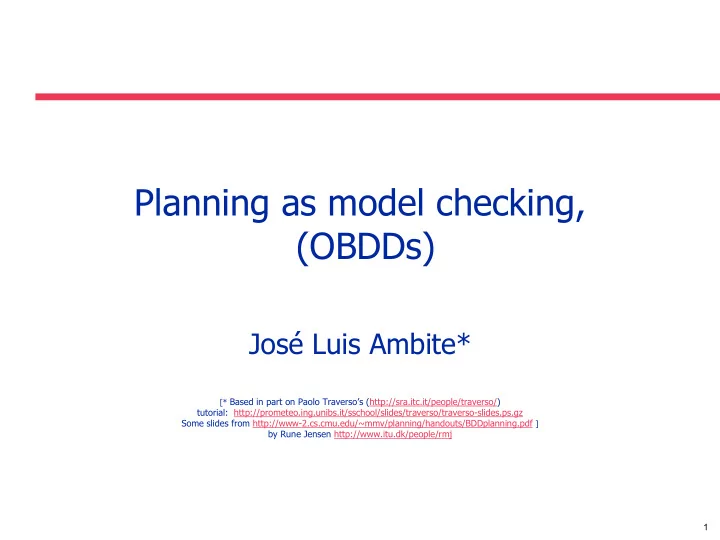

Planning as model checking, (OBDDs) José Luis Ambite* [* Based in part on Paolo Traverso’s (http://sra.itc.it/people/traverso/) tutorial: http://prometeo.ing.unibs.it/sschool/slides/traverso/traverso-slides.ps.gz Some slides from http://www-2.cs.cmu.edu/~mmv/planning/handouts/BDDplanning.pdf ] by Rune Jensen http://www.itu.dk/people/rmj 1
The Model Checking Problem Determine whether a formula is true in a model 1. A domain of interest is described by a semantic model 2. A desired property of the domain is described by a logical formula 3. Check if the domain satisfy the desired property by checking whether the formula is true in the model Motivation: Formal verification of dynamic systems 2
State Space: Blocks World 3
4
State-Transition Systems: Planning Domains A planning domain D is a 4-tuple <F, S, A, R>: � F is a finite set of Fluents � S ⊆ 2 F is a finite set of states � A is a finite set of actions � R ⊆ S x A x S is a transition relation Action a ∈ A is executable in s ∈ S if ∃ s’ R(s, a, s’) 5
State-Transition Systems: (Deterministic) Planning Domain Example: � F = {loaded, locked} � S = {( ¬ loaded locked), ( ¬ loaded ¬ locked), (loaded ¬ locked), (loaded locked)} � A = {lock, unlock, load, unload} � R = { [( ¬ loaded locked) unlock ( ¬ loaded ¬ locked)], [( ¬ loaded ¬ locked) lock ( ¬ loaded locked)], [( ¬ loaded ¬ locked) load (loaded ¬ locked)], [(loaded ¬ locked) unload ( ¬ loaded ¬ locked)], [(loaded ¬ locked) lock (loaded locked)], [(loaded locked) unlock (loaded ¬ locked)] } 6
State-Transition Systems: Planning Problem A planning problem P for a planning Domain D=<F S A R> is a 3-tuple <D, I, G>: � I ⊆ S is the set of initial states � G ⊆ S is the set of goal states G I 7
State-Transition Systems: Plan � A plan π for a planning problem P=<I, G, D> in a planning domain D = <F, S, A, R> is a set of state-action pairs: � {(s, a) : s ∈ S, a ∈ A, a executable in s} � at least one (s, a) with s ∈ I � Goal achieving plan (informally): � for each state-action pairs (s, a), either a leads from s to the goal, R(s, a) ∈ G, or a leads from s to a state s’ such that (s’, a’) ∈ π and a’ leads from s’ to the goal R(s’, a’) ∈ G, and so on. π = {(2, load), (3, lock)} 8
Planning Algorithm (Regression) Backward image (regress set of states) Remove Visited I 9
Planning Algorithm (Regression) Backward image (regress set of states) Remove Visited I G 10
Planning via Symbolic Model Checking � Problem: Realistic planning domains often have large state spaces � Idea: exploit the work on symbolic model checking based on Ordered Binary Decision Diagrams (OBDD’s) � OBDD’s: � Canonical form for propositional formulas � Efficient! � Polynomial boolean operations: O( ϕ 1 ⊗ ϕ 2 ) = O(| ϕ 1 | | ϕ 2 |) � Constant time equality 11
OBDD example: Variable ordering Is important 12
13
14
Planning via Model Checking Symbolic Representation � Action represented by assigning true to the corresponding variable � Transition t = <s a s’> encoded as ξ (t) = ξ (s) ^ ξ (a) ^ ξ (s’) � Transition relation T encoded as disjunction of all the transitions ξ (T)= V t ∈ T ξ (t) 15
Planning Algorithm (regression) I G 16
Planning Algorithm (regression) � OneStepPlan(S) in the regression algorithm is the backward image of the set of states S. � Can computed as the QBF formula: ∃ x’ (States(x’) ∧ R(x, a, x’)) � Quantified Boolean Formula (QBF): ∃ x φ (x y) = φ (0 y) ∨ φ (1 y) ∀ x φ (x y) = φ (0 y) ∧ φ (1 y) 17
18
19
20
21
Planning as model checking 22
Planning as Model Checking 23
24
25
26
27
28
29
30
31
32
Recommend
More recommend